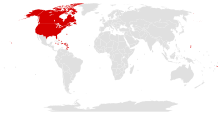
North American Numbering Plan
Integrated telephone numbering plan of twenty North American countries / From Wikipedia, the free encyclopedia
Dear Wikiwand AI, let's keep it short by simply answering these key questions:
Can you list the top facts and stats about North American Numbering Plan?
Summarize this article for a 10 years old
The North American Numbering Plan (NANP) is a telephone numbering plan for twenty-five regions in twenty countries, primarily in North America and the Caribbean. This group is historically known as World Zone 1 and has the telephone country code 1. Some North American countries, most notably Mexico, do not participate in the NANP.
 Countries participating in the North American Numbering Plan | |
| Format | +1 NXX NXX-XXXX |
|---|---|
| Access codes | |
| Country code | 1 |
| International access | 011 |
| List of dialing codes | |
The concepts underlying the NANP were originally devised in the 1940s by the American Telephone and Telegraph Company (AT&T) for the Bell System and the independent telephone companies in North America in Operator Toll Dialing. The first step was to unify the diverse local telephone numbering plans that had been established in the preceding decades, with the goal to speed call completion times and lower the costs for long-distance calling, by reducing manual labor by switchboard operators. Eventually, it prepared the continent for direct-dialing of long-distance calls by customers, first possible in 1951 and expanded across the nation in the decades following. AT&T continued to administer the continental numbering plan and the technical infrastructure until the breakup of the Bell System, when administration was delegated to the North American Numbering Plan Administrator (NANPA), a service that has been procured from the private sector by the Federal Communications Commission (FCC) in the United States. Each participating country forms a regulatory authority that has plenary control over local numbering resources.[1] The FCC also serves as the U.S. regulator. Canadian numbering decisions are made by the Canadian Numbering Administration Consortium.[2]
The NANP divides the territories of its members into numbering plan areas (NPAs) which are encoded numerically with a three-digit telephone number prefix, commonly called the area code.[3] Each telephone is assigned a seven-digit telephone number unique only within its respective numbering plan area. The telephone number consists of a three-digit central office (or exchange) code and a four-digit station number. The combination of an area code and the telephone number serves as a destination routing address in the public switched telephone network (PSTN). The North American Numbering Plan conforms with International Telecommunication Union (ITU) Recommendation E.164, which establishes an international numbering framework.[4]